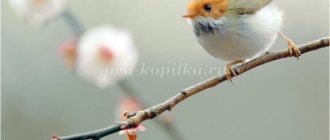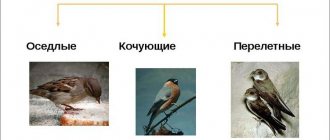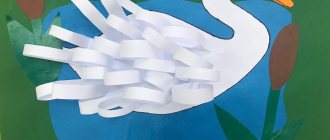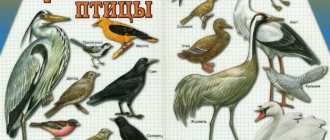Summary of an ecology lesson for children 5-6 years old on the topic: “Feathered friends”
Summary of an ecology lesson for children 5-6 years old on the topic: “Feathered friends”
Target
: formation of ecological culture; generalization of the idea of wintering and migratory birds.
Tasks:
Educational:
To clarify children’s knowledge about the characteristics of birds: appearance, habitat, nutrition;
Activate the dictionary on the lexical topic: “Wintering and migratory birds”;
Learn to use possessive adjectives: pigeon, sparrow, etc.
Educational:
To develop skills in caring for birds in winter;
Develop thinking, observation, speech, cognitive interest;
Develop gross motor skills, coordination of speech with movement.
Educational:
Cultivate a caring and attentive attitude towards birds, a desire to help them in winter;
Foster a desire to receive and find new knowledge about birds;
Help maintain positive emotions throughout the lesson.
Priority educational areas
: cognitive-speech and artistic-aesthetic development.
Equipment:
tree models, silhouettes of wintering and migratory birds, illustrations of wintering and migratory birds;
record player. Preliminary work:
conversations, observations, looking at illustrations, reading fiction, creative activity
(modeling, drawing, applique).
Progress of organized educational activities.
1 part
.
Surprise moment
: a crow appears, there is a letter in its beak, with a cry of “kar-kar, trouble, trouble,” it throws the letter and flies away. (“I pick it up” and read the letter: “Dear guys! An old forest man is writing to you. Something bad has happened in our forest! The evil sorceress Vyuzhka drove all the birds out of our forest. And without them it’s very bad. Please help me get them back. In the envelope you You will find tasks, after which the birds will return to the forest, a magic wand and a magic spell in order to quickly find yourself in the autumn forest.”
- Well, guys, let’s help the old forest man return the birds?
Children: yes.
“Then get ready, close your eyes, I’ll wave my magic wand, cast a magic spell, and you and I will find ourselves in the forest:
“Autumn forest, marvelous forest,
Full of fairy tales and miracles,
You, open up to us quickly,
Surprise our children"
I slowly pronounce the “spell”, at this time the junior teacher arranges models of trees.
- Open your eyes.
- What forest did we find ourselves in? Describe it.
Children: autumn, beautiful, etc.
-How beautiful it is in the forest! The forest is dressed in autumn attire. The trees are in autumn decoration. And how quiet it is in the forest, no one disturbs its peace.
“But you really can’t see the birds.” And in order to return them, we need to complete the tasks that the old forest man wrote to us about. And here is the first task: you need to guess the description riddle. And you will help me with this. Let’s just agree that we will listen to the riddles to the end.
Game " Guess the description"
". I explain the rules of the game.
The child comes out, closes his eyes, and puts a woodpecker cap on his head.
Who can tell us what you know about this bird? If there is not enough information, I ask another child or add it myself.
Child: this bird lives in the forest. You can call him handsome. His back is black, his belly is white with black specks, and on his head there is a bright red spot, like a beret. She has a very strong beak. With its strong beak it can make a hole in a solid tree trunk. And its tongue is long, penetrates into a gap in the bark and deftly takes out beetles - bark beetles and other insects. He feeds on them.
Child: he is called the forest orderly because he saves the tree from bark beetles and other harmful insects.
Child: he also eats seeds from pine and fir cones.
- Well, did you guess who it is?
Child: woodpecker.
- And then the woodpecker flew in and sat on the tree.
Next, I invite the second child and put on a bullfinch cap.
Child: this bird has black wings and a red breast; the bird got its name because it flies to us with the first snow.
Child: these birds feed on rowan berries, sea buckthorn, barberry, and plant seeds.
-Who is this bird?
Child: bullfinch.
- That's right, so the bullfinch flew in and sat on a branch
I also ask the next child to close his eyes and put on a tit’s cap.
-Who will tell us about this bird?
Child: This is a wintering bird and has a yellow breast. They are very nimble and lively birds; they survive the winter, hiding in a hollow. In spring and summer they feed on various insects, but in winter, when there is not enough food in the forest, the birds have a hard time. In search of food, they fly to human habitation.
Child: tits, in addition to seeds, like to peck fresh, unsalted lard.
Well, guess what kind of bird this is?
Child: tit.
- And then a tit flew in and sat on a tree.
- And the last bird must be described.
I put a magpie cap on the child’s head.
- Who will tell us about this bird? Child: This bird is a white-sided long-tailed fidget. She is very curious. He sees something shiny - a coin or a piece of glass, and looks at it with his round eye. Then he will grab you and drag you into his nest. They are omnivorous birds.
-What kind of bird is this?
Child: forty.
- Look what a lively flock has settled on the tree. The birds in this flock are different, but they all belong to what kind of birds, what can you call them in one word?
Children: Wintering.
- Guys, now I’ll turn you into birds. (I quickly distribute bird silhouettes to each child)
Fizminutka
The bird fluttered its wings,
The bird flapped its wings,
Waved, flew,
She sat down and pecked the grains.
Game "At the feeding trough".
- You have the silhouette of a bird in your hands, look, remember what kind of bird it is and listen carefully to the poem. The bird that hears about itself “flies” to the “feeder”. (Children attach the bird to the magnetic board.)
— Poem by Zinaida Alexandrova “New Dining Room”:
We made a feeding trough, We opened a dining room. On the first day of the week, tits came to visit us. And on Tuesday, look, the bullfinches arrived.
Three crows were there on Wednesday, We weren't expecting them for lunch. And on Thursday from all over the world - a flock of greedy sparrows.
On Friday, in our dining room, Golub enjoyed porridge. And on Saturday seven forty flew into the pie.
On Sunday, on Sunday, a spring guest flew to us - the starling traveler... That’s the end of the song.
- Guys, what bird do you think is the odd one out here?
Children: starling.
- Right, why?
Children: the starling is a migratory bird.
— What other migratory birds do you know?
The children name and I show pictures: cuckoo, swallow, nightingale, rook.
- Why didn’t these birds stay with us for the winter?
Children: Birds that fly away from us for the winter eat various insects: beetles, flies, midges...
— That’s right, when it gets cold and insects hide in cracks, climb deep under the bark, birds can’t reach them, so they fly away from us to warmer climes, where it’s warm and there’s plenty of food.
- So, we have completed the first task, but there is another task in the envelope: d/i “ Guess the bird from the photo”
". If you can do it, the whole flock of birds will delight us with their singing.
I hand out pictures of parts of a bird to the children, explain that the photographer took unsuccessful photographs and they need to guess what kind of bird the photographer photographed. I ask: whose tail? (Lastochkin), etc.
- Now we have completed the second task. Listen, guys, the birds came to life and began to sing (the recording “Sounds of Birds” is playing).
Part 2.
-Guys, let's make the wintering birds happy and make a tasty treat for them.
Children approach the tables on which there are pine cones, birdseed, and paste in jars on trays. I show you a sample of the task. Next, the children make their own treats for the birds. Dip the cones into the paste, and then into the food and place them on a tray.
- What a great fellow you are, how many delicious treats you were able to make for the birds. During our walk, we will hang our treats on branches and delight the birds.
Reflection
.
— Guys, what did you like most about our lesson? What new did you learn? What was difficult for you? What will you talk about at home?
- Our lesson is over, well done everyone.





